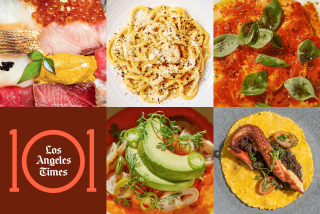Foods find the right mouth-feel
Anyone who ate gluten-free food five or 10 years ago might understandably opt to avoid such food forever after. In the old days, “we used to joke that when you got the food, you didn’t know if you were supposed to eat the box or the contents,” says Dr. Alessio Fasano, medical director of the Center for Celiac Research at the University of Maryland.
The taste and texture were pretty bad, agrees Scott Mandell, chief executive and co-founder of Enjoy Life Natural Brands, which makes gluten-free and allergy-friendly foods. “They gave a very gluten-free taste, which means kind of a mealy and bland, crumbly taste,” he says. “They didn’t give a good mouth-feel. If you ate a cookie, you didn’t want another one.”
That’s because gluten plays a key role in providing structure to baked goods. During cooking, proteins in gluten create a sub-microscopic network that traps gas bubbles and adds viscosity and elasticity to the mix. When the product is heated, the moisture evaporates and the gluten becomes rigid, setting texture and structure.
Some of the old gluten foods weren’t even particularly healthful. “Typically, gluten-free foods have been made with refined gluten-free products, including white rice flour, tapioca starch, corn starch and potato starch,” says Shelley Case, a registered dietitian and author of “Gluten-Free Diet: A Comprehensive Resource Guide.” “They added a lot of fat and sugar to make it taste palatable and stick together, so the food wasn’t very good for you.”
But in the last few years, gluten-free foods have gotten tastier and more healthful.
Companies specializing in gluten-free foods are incorporating a wide variety of ingredients, often milled into flour to improve the products’ flavor and nutritional content, including amaranth, quinoa, garbanzo beans, navy beans, fava beans, buckwheat, almonds, hazelnut, millet, brown rice, sorghum, flax and even mesquite pods and Indian rice grass.
Some products have been developed by small family ventures, often parents of kids with celiac disease or others who suffer from the disorder. Finding few ready-made gluten-free foods in the grocery store, they began experimenting at home and spun off their recipes into a cottage industry.
Single mom Shari Cole of Thousand Oaks, for example, two years ago co-launched a line of gluten-free foods, Gluten Free & Fabulous, after struggling to find tasty food for her daughter, who is mildly autistic.
“Some people laughed at us, saying that [gluten-free food] was a fad,” Cole says. “But we got sick of eating bad food that tasted like cardboard.” Sales have quadrupled in the last year, she says. “We recently got a nice order from Dubai.”
Some of the new offerings have gotten a boost from an unexpected source: a current fascination with ancient grains -- such as amaranth, quinoa and teff. These don’t have the gluten proteins that trigger celiac disease, food trends forecaster Suzy Badaracco says. “So if you’ve got a product with ancient grains, if you’re smart, you tie it into both trends -- gluten-free and ancient grains. It’s a double whammy.”
More to Read
Eat your way across L.A.
Get our weekly Tasting Notes newsletter for reviews, news and more.
You may occasionally receive promotional content from the Los Angeles Times.






